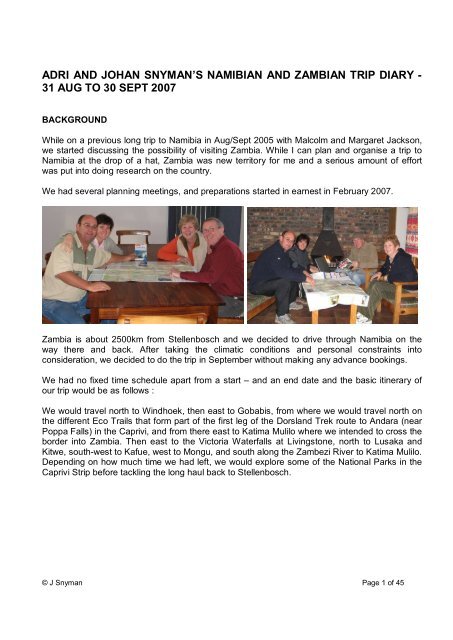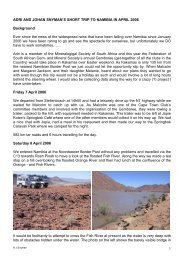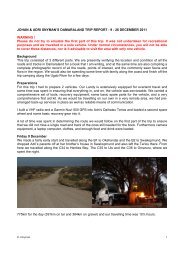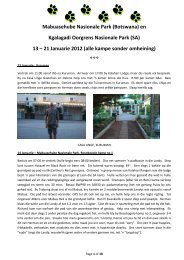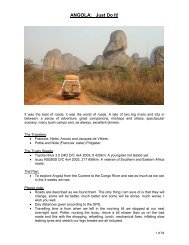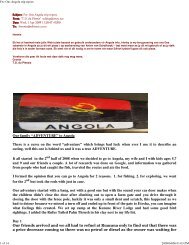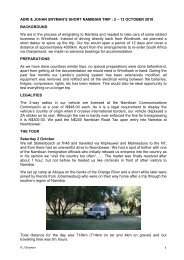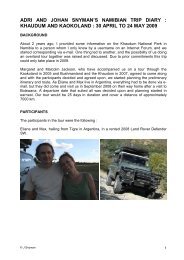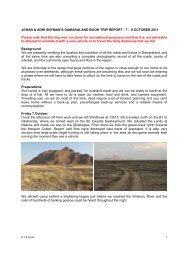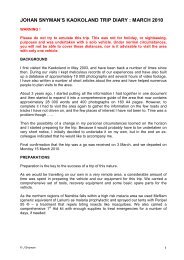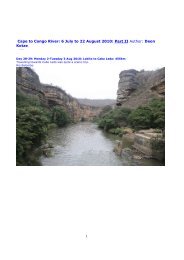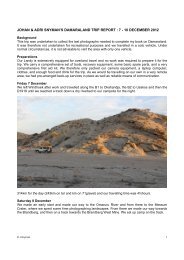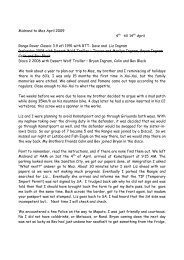adri and johan snyman's namibian and zambian trip diary
adri and johan snyman's namibian and zambian trip diary
adri and johan snyman's namibian and zambian trip diary
You also want an ePaper? Increase the reach of your titles
YUMPU automatically turns print PDFs into web optimized ePapers that Google loves.
ADRI AND JOHAN SNYMAN’S NAMIBIAN AND ZAMBIAN TRIP DIARY -<br />
31 AUG TO 30 SEPT 2007<br />
BACKGROUND<br />
While on a previous long <strong>trip</strong> to Namibia in Aug/Sept 2005 with Malcolm <strong>and</strong> Margaret Jackson,<br />
we started discussing the possibility of visiting Zambia. While I can plan <strong>and</strong> organise a <strong>trip</strong> to<br />
Namibia at the drop of a hat, Zambia was new territory for me <strong>and</strong> a serious amount of effort<br />
was put into doing research on the country.<br />
We had several planning meetings, <strong>and</strong> preparations started in earnest in February 2007.<br />
Zambia is about 2500km from Stellenbosch <strong>and</strong> we decided to drive through Namibia on the<br />
way there <strong>and</strong> back. After taking the climatic conditions <strong>and</strong> personal constraints into<br />
consideration, we decided to do the <strong>trip</strong> in September without making any advance bookings.<br />
We had no fixed time schedule apart from a start – <strong>and</strong> an end date <strong>and</strong> the basic itinerary of<br />
our <strong>trip</strong> would be as follows :<br />
We would travel north to Windhoek, then east to Gobabis, from where we would travel north on<br />
the different Eco Trails that form part of the first leg of the Dorsl<strong>and</strong> Trek route to Andara (near<br />
Poppa Falls) in the Caprivi, <strong>and</strong> from there east to Katima Mulilo where we intended to cross the<br />
border into Zambia. Then east to the Victoria Waterfalls at Livingstone, north to Lusaka <strong>and</strong><br />
Kitwe, south-west to Kafue, west to Mongu, <strong>and</strong> south along the Zambezi River to Katima Mulilo.<br />
Depending on how much time we had left, we would explore some of the National Parks in the<br />
Caprivi S<strong>trip</strong> before tackling the long haul back to Stellenbosch.<br />
© J Snyman Page 1 of 45
PARTICIPANTS<br />
The participants in the tour would be the following :<br />
Malcolm <strong>and</strong> Margaret Jackson in their 1994 L<strong>and</strong> Rover Defender Tdi CSW.<br />
Adri <strong>and</strong> I in our 1998 L<strong>and</strong> Rover Defender Tdi Hardtop.<br />
© J Snyman Page 2 of 45
PREPARATIONS<br />
Both vehicles, <strong>and</strong> their equipment, received a thorough service <strong>and</strong> going over before the <strong>trip</strong><br />
<strong>and</strong> a fairly comprehensive list of spares were taken along.<br />
As the northern regions of Namibia <strong>and</strong> the whole of Zambia falls within a high risk malaria area<br />
we used Mefliam (generic equivalent of Larium) as malaria prophylactic <strong>and</strong> sprayed our tents<br />
with Peripel 55 – a treatment that repels biting insects like mosquitoes. Although it was not a<br />
requirement, we were also inoculated against yellow fever, hepatitis <strong>and</strong> typhoid, to supplement<br />
the up to date ones we have for polio, tetanus <strong>and</strong> diphtheria.<br />
On a tour like this your selection of clothing is extremely important as you need to make<br />
provision for different temperatures, insects, dusty conditions etc etc. We have found that the<br />
technical clothing sold at outlets specialising in hiking- <strong>and</strong> outdoor wear best suit our purposes<br />
as they fit comfortably, come in neutral colours, are easily washed <strong>and</strong> are fast drying. Trousers<br />
with zip-off legs are also easily converted from day-time to evening wear. Light-weight hiking<br />
boots are comfortable to wear <strong>and</strong> protect your feet a lot better than open s<strong>and</strong>als do.<br />
We take a laptop computer along on our <strong>trip</strong>s to download photos <strong>and</strong> GPS data <strong>and</strong> also keep<br />
a <strong>trip</strong> <strong>diary</strong>. But, you need to keep the security of your data in mind <strong>and</strong> for this we take along an<br />
external hard drive <strong>and</strong> CD’s to make back-ups. These are kept separately from the laptop –<br />
preferably in another vehicle.<br />
LEGALITIES<br />
Licenses for our 29Mhz radios were obtained for Namibia <strong>and</strong> Zambia. The Namibian one is<br />
obtainable from the Namibian Communications Commission, Private Bag 133309, Windhoek or<br />
Fax 00264 61 222 790. The licence is valid from 1 Jan to 31 Dec <strong>and</strong> is issued within a matter of<br />
days <strong>and</strong> is the form of a disc that is stuck to the inside of the vehicle’s windscreen. The<br />
Zambian one is available from the Zambian Communications Authority <strong>and</strong> a very helpful<br />
Mr Kezias Mwale can be contacted at kmwale@caz.gov.zm in this regard. Please note that this<br />
licence will take a while to obtain …………<br />
We all displayed ZA stickers on the rear of our vehicles as it is a legal requirement to display the<br />
vehicle’s country of origin when it crosses international borders. We also affixed s<strong>trip</strong>s of<br />
reflective material to our vehicles to comply with Zambian regulations. 2 x white s<strong>trip</strong>s to the<br />
front <strong>and</strong> 2 x red s<strong>trip</strong>s to the rear (minimum 75mm long x 50mm wide each). Each vehicle also<br />
carried 2 warning triangles as this is an item often asked for at police checkpoints in Zambia.<br />
We paid our Namibian Road Tax of N$160 per vehicle upon entry at Noordoewer <strong>and</strong> again<br />
upon re-entry at Katima Mulilo.<br />
As Malcolm <strong>and</strong> Margaret hold British Passports they had to obtain Visas to enter Zambia.<br />
These can be obtained at the border but you need to take the required documentation with you.<br />
The Taxes to be paid, <strong>and</strong> the administrative process involved, upon entry into Zambia is a<br />
complicated <strong>and</strong> laborious affair. You pay a Local Council entrance tax, carbon emission tax<br />
(dependant on engine size) <strong>and</strong> 3 rd party insurance for your vehicle.<br />
© J Snyman Page 3 of 45
THE TOUR<br />
Friday 31 August<br />
It was cold with a light drizzle when we left Stellenbosch <strong>and</strong> travelled via Klipheuwel <strong>and</strong><br />
Malmesbury to the N7 from where we started travelling northwards. Near Malmesbury we saw<br />
fields of green wheat <strong>and</strong> yellow flowering Canola <strong>and</strong> from Citrusdal onwards we saw some<br />
beautiful flowers along the way.<br />
Malcolm <strong>and</strong> Margaret left Cape Town a bit later than we did, so we kept our speed down so<br />
that they could catch up <strong>and</strong> they managed to do so as we arrived at the Noordoewer border<br />
post. As 3 busses had arrived at the border post just before us, we had to st<strong>and</strong> in a queue for<br />
almost 1½ hours to have our passports processed. The fact that the Narcotics Bureau had all<br />
their equipment set up in the middle of the road to search the baggage of the bus passengers<br />
did not improve the flow of traffic either. But, we passed through both control points without<br />
incident <strong>and</strong> after refuelling our vehicles we pitched camp next to the Orange River at Abiqua.<br />
The campsite was neat <strong>and</strong> tidy <strong>and</strong> the cost of accommodation was N$55-00 per person with a<br />
further N$10-00 for the use of an electrical power point.<br />
Total distance for the day was 713km (709 on tar- <strong>and</strong> 4km on gravel roads) <strong>and</strong> travelling time<br />
was a leisurely 9½ hours.<br />
© J Snyman Page 4 of 45
Saturday 1 September<br />
After a very quiet night we had an uneventful drive to Windhoek, where we first visited some<br />
family before we settled in at the camping sites at Arebbusch for the night. The campsite was<br />
neat <strong>and</strong> tidy <strong>and</strong> the cost of accommodation for the 4 of us amounted to N$300.<br />
As the l<strong>and</strong>scape on the Namibian side of the Orange River is a lot more arid, we had a hard<br />
time locating a flower for spring day ……<br />
Total distance for the day was 841km (837 on tar- <strong>and</strong> 4km on gravel roads) <strong>and</strong> travelling time<br />
was 9½ hours.<br />
© J Snyman Page 5 of 45
Sunday 2 September<br />
After a not so quiet night, due to the proximity of some busy roads <strong>and</strong> an airport, we first did<br />
some last minute shopping in Windhoek before we departed for Gobabis where we refuelled the<br />
vehicles <strong>and</strong> filled our Jerrycans, as the availability of fuel on our intended route was uncertain.<br />
We travelled along the MR119 towards Rietfontein <strong>and</strong> turned off on the Dorsl<strong>and</strong> Trail at<br />
Talismanus. Petrol <strong>and</strong> diesel was available at a building on the left-h<strong>and</strong> side of the road in<br />
Talismanus.<br />
The route was very s<strong>and</strong>y right from the start with bush encroachment right to the edge of the<br />
track. This is not the place for the faint-hearted with vehicles that have shiny paintwork ! We<br />
slept on the site reported to be the last camping spot of the late Jan Joubert <strong>and</strong> spent a<br />
considerable time contemplating al the things this remarkable man might still have achieved if he<br />
did not meet his untimely end.<br />
Total distance for the day was 497km (227 on tar- <strong>and</strong> 270km on gravel- <strong>and</strong> s<strong>and</strong> roads) <strong>and</strong><br />
travelling time was 8½ hours.<br />
Monday 3 September<br />
We had a very quiet night <strong>and</strong> awoke to the plaintive cries of a lonely jackal at sunrise.<br />
We visited the site where Jan Joubert was murdered <strong>and</strong> also the site where his body was<br />
eventually found.<br />
© J Snyman Page 6 of 45
The s<strong>and</strong>y track continued to a point where it intersects the Epukiro River <strong>and</strong> from there on is<br />
called the Bushmanl<strong>and</strong> Eco Trail. It continuous along this river over farml<strong>and</strong> with lots of cattle,<br />
but hardly any game animals or birds were to be seen.<br />
We drove along a s<strong>and</strong>y road right alongside the Botswana border until we reached an open<br />
space in the vegetation where we set up camp for the night.<br />
Total distance for the day was 170km (all of it on s<strong>and</strong> roads) <strong>and</strong> travelling time was 9½ hours.<br />
© J Snyman Page 7 of 45
Tuesday 4 September<br />
We had a very quiet night <strong>and</strong> awoke to the toc-toc-toc calls of the hornbills roosting in the trees<br />
before continuing along the s<strong>and</strong>y track until we reached the Veterinary Control Point on the<br />
D3831. Meat may be transported to the north of this position but may not be transported south.<br />
From there we continued along a good gravel road until we entered the Nyae Nyae<br />
Conservancy <strong>and</strong> turned off onto the Nyae-Nyae Eco Trail to Tsumkwe. The scenery changed<br />
with more open grassl<strong>and</strong>s <strong>and</strong> some huge baobab trees.<br />
The local bushman villages were a bit of a disappointment to see as the people have adopted<br />
western-style culture <strong>and</strong> seem to be struggling to survive. There is no attempt made to grow<br />
any crops <strong>and</strong> meat is obtained by hunting. As the area is so dry at present, a bowl of water is<br />
used as bait in traps to catch birds. They are also setting fire to the veld to improve visibility <strong>and</strong><br />
stimulate new growth of grass to improve hunting opportunities. One of these veld fires got the<br />
adrenaline going when the wind changed direction <strong>and</strong> we almost got caught up in the flames.<br />
© J Snyman Page 8 of 45
Although there were plenty of signs of elephant, we only encountered a solitary animal as we<br />
proceeded via Keba-, Nyae Nyae- <strong>and</strong> Vogel Pans.<br />
We set up camp at the Tsumkwe Lodge <strong>and</strong> the cost of the accommodation amounted to N$55<br />
per person. They have very good facilities, hot water in the showers, firewood is supplied <strong>and</strong><br />
© J Snyman Page 9 of 45
we even had a very nice cooling down in the swimming pool. One of the dogs of the Lodge<br />
owner came to introduce herself <strong>and</strong> faithfully sat next to our vehicles for the whole night.<br />
Total distance for the day was 197km (all of it on s<strong>and</strong>- <strong>and</strong> gravel roads) <strong>and</strong> travelling time<br />
was 9 hours.<br />
Wednesday 5 September<br />
We topped up the fuel tanks at the Offices of the Department of Agriculture before undertaking<br />
the Baobab Eco Trail. There are some huge baobabs to be seen along this route <strong>and</strong> some of<br />
them are of historical importance as they acted as l<strong>and</strong>marks for the Dorsl<strong>and</strong> Trekkers. One<br />
half of the “Dorsl<strong>and</strong>” baobab has collapsed <strong>and</strong> is lying in a rotten mass. The names of some<br />
German Schutztruppen (H Gathemann, E Hewer <strong>and</strong> D Hanneman) are carved into the bark of<br />
the remaining part of the tree together with the date 18 February 1891. Can you imagine what<br />
these ancient trees must have witnessed during their life spans ?<br />
© J Snyman Page 10 of 45
From there, we departed for the Kaudom National Park where we set up camp at Sekerreti<br />
Campsite where the facilities are so dilapidated that it can be considered to be non-existent. We<br />
only had to pay Park Entrance Fees (N$30-00 per adult <strong>and</strong> N$10-00 per vehicle) <strong>and</strong> not for<br />
the camping sites. Here we also encountered the first other tourists <strong>and</strong> vehicle since leaving<br />
Talismanus. I also discovered that the dust cap on the hub of the right rear wheel had gone<br />
astray along the way <strong>and</strong> that the grease on the protruding end of the half-shaft was covered in<br />
s<strong>and</strong>. Instead of removing the affected parts <strong>and</strong> cleaning them properly, I merely wiped most of<br />
the grit off <strong>and</strong> covered the hub with duct tape. This would prove to be a stupid mistake later on<br />
in the <strong>trip</strong> ……<br />
© J Snyman Page 11 of 45
Soon after we retired for the night the elephants moved into the campsite <strong>and</strong> started feeding on<br />
the trees <strong>and</strong> some hyenas giggled in the distance.<br />
Total distance for the day was 149km (all of it on s<strong>and</strong>- <strong>and</strong> gravel roads <strong>and</strong> -tracks) <strong>and</strong><br />
travelling time was 7½ hours.<br />
Thursday 6 September<br />
Apart from the noise the elephants made during the night, everything was very quiet night <strong>and</strong><br />
we awoke to the shrill calls of francolin at sunrise.<br />
We made our way via the Soncana waterhole, along the Nhoma River to the Omuramba<br />
Waterhole, Tari Kora Waterhole, Leeupan <strong>and</strong> Tsau Waterhole - where the adrenaline flowed<br />
when an elephant charged our vehicle, to Kaudom Restcamp. We saw some large herds of<br />
elephant, 3 small herds of the endangered Roan Antelope, some very unafraid kudu <strong>and</strong> a<br />
number of duiker along the way. There was a huge fire burning in the western regions of the<br />
park <strong>and</strong> the flames were being fanned by a wind blowing in an easterly direction. Some of the<br />
tracks had very loose <strong>and</strong> deep s<strong>and</strong> <strong>and</strong> the going became more difficult.<br />
© J Snyman Page 12 of 45
The facilities at Kaudom Restcamp were also non-existent <strong>and</strong> we were invited to make use of<br />
the ablution facilities at the staff village. We again only had to pay Park Entrance Fees (N$30-00<br />
per adult <strong>and</strong> N$10-00 per vehicle).<br />
Total distance for the day was 113km (all of it on s<strong>and</strong> tracks) <strong>and</strong> travelling time was 8 hours.<br />
Friday 7 September<br />
We awoke with the strong smell of wood smoke from the approaching fire <strong>and</strong> therefore made<br />
an early start. Parts of the veld we drove through have been devastated by a recent fire <strong>and</strong> the<br />
road was a very loose s<strong>and</strong>y track. Numerous trees were also lying across the track – some<br />
have fallen over after being burnt, but most had been pushed over by elephants - <strong>and</strong> this gave<br />
rise to some very interesting <strong>and</strong> challenging detours.<br />
© J Snyman Page 13 of 45
© J Snyman Page 14 of 45
The s<strong>and</strong>y track ended at the tarred B8, which we crossed before continueing along the gravel<br />
D3411 <strong>and</strong> then on the D3402 alongside the Okavango River to Andara <strong>and</strong> Divundu.<br />
Andara was the end of the first leg of the Dorsl<strong>and</strong> Route <strong>and</strong> we visited the Roman Catholic<br />
Mission Church <strong>and</strong> the cemetery, which covers a large area <strong>and</strong> is sadly neglected in some<br />
parts.<br />
The Shell Garage at Divundu had no fuel, but we managed to fill our tanks at the nearby Engen<br />
Garage. From Gobabis to Divundu (1065km) our L<strong>and</strong>y used 156- <strong>and</strong> Malcolm’s one 151 litres<br />
of diesel. The heavy fuel consumption was mainly as a result of the very loose s<strong>and</strong><br />
encountered along the major portion of the route <strong>and</strong> is a factor to be reckoned with when<br />
planning to undertake this route.<br />
After 8 days of travelling it was time for a short break <strong>and</strong> we decided to spoil ourselves by<br />
booking into a 4 bed bungalow at Popa Falls. The cost thereof amounted to N$360-00 per day<br />
for the 4 of us <strong>and</strong> included breakfast. All the facilities were neat <strong>and</strong> tidy, with hot showers <strong>and</strong><br />
electrical power points in the bungalows <strong>and</strong> at the campsites.<br />
A lonely hippopotamus was roaming the campsite <strong>and</strong> made a beeline for the protection of the<br />
reeds next to the river every time it saw someone.<br />
Total distance for the day was 167km (9km on tar- <strong>and</strong> 158km on s<strong>and</strong>- <strong>and</strong> gravel roads) <strong>and</strong><br />
travelling time was 7½ hours.<br />
© J Snyman Page 15 of 45
Saturday 8 September<br />
After a very good night’s sleep we awoke to a chorus of birdsong. As this was to be a rest day<br />
we did not even start our vehicles <strong>and</strong> instead explored the area on foot. We also tried to catch<br />
some tiger fish <strong>and</strong> Malcolm did manage to catch one while I hooked <strong>and</strong> lost one. I also spent<br />
some time updating the <strong>trip</strong> <strong>diary</strong>, sorting the photos <strong>and</strong> making backups on a portable hard<br />
drive <strong>and</strong> on CD’s.<br />
Sunday 9 September<br />
After another good night’s sleep we again woke to the chorus of birdsong <strong>and</strong> were soon<br />
packing our vehicles to start off on the next leg of our <strong>trip</strong>.<br />
We made our way via the B8 to Katima Mulilo where we did some last minute shopping before<br />
making our way to the border post to cross into Zambia. The border post was bustling with<br />
© J Snyman Page 16 of 45
activity as a new complex is being constructed on the Namibian side. To have al the formalities<br />
completed on the Namibian side took about 5 minutes but it took 1½ hours to be cleared on the<br />
Zambian side. As the Jackson’s travel on British Passports they had to get single entry visa’s on<br />
the border, but the official manning the desk had no idea which forms were to be completed<br />
even though Margaret had obtained <strong>and</strong> completed them beforeh<strong>and</strong>. He also only knew the<br />
cost of the visa in pounds sterling <strong>and</strong> had no idea of the exchange rate to be used so that it<br />
could be paid for in the currency we had available. For each of the vehicles we had to pay a<br />
Local Council entrance tax of ZAR75-00, Carbon Emission Tax amounting to ZAR300-00 <strong>and</strong> 3 rd<br />
Party Insurance amounting to ZAR220-00. These moneys can be paid in US$, N$, ZAR or<br />
Kwacha, but you need to keep a calculator h<strong>and</strong>y as each official uses a different exchange rate<br />
<strong>and</strong> it is to your advantage to pay in the currency giving the most advantageous price.<br />
There were a few noticeable differences between the Namibian <strong>and</strong> Zambian side of the border.<br />
Although the people look the same, live in similar houses <strong>and</strong> in similar villages, the people on<br />
the Zambian side have planted fruit- <strong>and</strong> flowering trees between their houses <strong>and</strong> many also<br />
had vegetable gardens while this in not often seen on the Namibian side. You also saw many<br />
people on bicycles in Zambia <strong>and</strong> there were lots of small children everywhere …….<br />
© J Snyman Page 17 of 45
About halfway to Livingstone we encountered a Foot <strong>and</strong> Mouth Disease Control post….. They<br />
only wanted to know if we were transporting any beef or dairy products <strong>and</strong> then we had to climb<br />
out of our vehicles to wash our h<strong>and</strong>s in a basin with water. The officials were unable to explain<br />
why we had to do so <strong>and</strong> did not spray the undersides of the vehicles, treat their tyres or the<br />
soles of our shoes, etc<br />
We made our way to Livingstone where we stayed in the safari-style tents of the Maramba River<br />
Lodge. Camping would have cost us US$10 per person while the tents cost US$45 per couple.<br />
However, it would mean that we did not need to pack up every morning. The tents have<br />
electrical power outlets which we used to power the fridges in our vehicles for the duration of our<br />
stay.<br />
That evening we had our first encounter with the campsite’s resident population of bushbabies.<br />
As darkness fell, these inquisitive animals soon came to have a look at what we were doing <strong>and</strong><br />
having for supper. It is actually quite amazing to see how far they can leap from one place to<br />
another without any apparent effort. They are very partial to certain types of food, such as<br />
biscuits <strong>and</strong> sausage, <strong>and</strong> this should not be left unattended.<br />
The tarred road between Divundu to Katima Mulilo <strong>and</strong> from there to Livingstone was in<br />
excellent condition. Total distance for the day was 556km (554 km on tar- <strong>and</strong> 2km on gravel<br />
roads) <strong>and</strong> travelling time was 9½ hours.<br />
© J Snyman Page 18 of 45
Monday 10 September<br />
We awoke with the sounds of aircraft, as all types of craft, ranging from microlights, helicopters,<br />
vintage bi-planes etc fly tourists over the Falls from sunrise to sunset every day. This day was<br />
set aside to explore the Zambian side of the Victoria Waterfalls <strong>and</strong> we were soon doing just<br />
that.<br />
As we were visiting the area in the dry season, the flow of water over the ±100m high Falls are<br />
much reduced but they are no less spectacular. The rock formations, normally hidden behind<br />
<strong>and</strong> below water <strong>and</strong> spray, can now also be seen. There is a whole network of paths to different<br />
viewpoints <strong>and</strong> it is impossible for photographs to do justice to the sights that await you.<br />
© J Snyman Page 19 of 45
Afterwards we visited the new Spar shopping complex in Livingstone where we exchanged<br />
some money (Instant kwacha millionaires !) <strong>and</strong> bought fresh bread <strong>and</strong> beers. Products sold in<br />
the shops in Zambia are very expensive compared to what we are used to at home (About 3 x<br />
SA prices). For example, the local beer, Mosi Lager costs about K4000 while the SAB products<br />
are selling at about K7000 each (±R13-00).<br />
Tuesday 11 September<br />
As Adri <strong>and</strong> I wanted to see the Falls from the Zimbabwean side as well, we joined the queue of<br />
people that were crossing the border on foot early the morning. There were also a large number<br />
of trucks waiting to be cleared on both sides of the border. Trucks leaving Zambia were mostly<br />
carrying sheets of copper <strong>and</strong> timber while those entering Zambia were loaded with mining<br />
equipment <strong>and</strong> coal.<br />
© J Snyman Page 20 of 45
We were not disappointed as the Falls are even more spectacular when viewed from the<br />
Zimbabwean side.<br />
During the afternoon we visited the very interesting Livingstone museum <strong>and</strong> after that we went<br />
on one of the sundowner “booze” cruises. Food <strong>and</strong> drinks are included in the cost of the cruise<br />
<strong>and</strong>, unless you stop them, the waiters will bring drinks faster than you can consume them.<br />
© J Snyman Page 21 of 45
Wednesday 12 September<br />
We made our way along the T1 highway from Livingstone to Monze <strong>and</strong> soon encountered the<br />
first road block. There are a countless number of these Police check points along all the major<br />
routes but we found the officials manning them to be very courteous <strong>and</strong> did not experience any<br />
problems whatsoever at any one of them. The road between Livingstone <strong>and</strong> Zimba (76km) was<br />
potholed but from there onwards the road surface improved <strong>and</strong> good average speeds could be<br />
maintained.<br />
Near Kalomo we visited the “Administrator’s House” – the first non-traditional brick house built in<br />
Northern Rhodesia in +- 1903 for the British South African Company’s Administrator of North<br />
Western Rhodesia. It is a National Monument <strong>and</strong> is currently undergoing renovations. From<br />
there we proceeded to Choma, where we visited the museum <strong>and</strong> then on to Monze, where we<br />
stayed at the Moorings Campsite under some large shady trees. The cost to camp was US$5-00<br />
per person. They have clean ablution facilities with hot showers <strong>and</strong> each campsite is provided<br />
with an electrical outlet <strong>and</strong> water on tap.<br />
© J Snyman Page 22 of 45
Total distance for the day was 335km (316km on tar- <strong>and</strong> 19km on gravel roads) <strong>and</strong> travelling<br />
time was 7 hours.<br />
Thursday 13 September<br />
We made our way along the T1 to the junction with the T2 <strong>and</strong> from there to Lusaka – the<br />
Capital City of Zambia. It is a big place with high rise buildings, shopping malls <strong>and</strong> lots of<br />
vehicles. We replenished some of our supplies <strong>and</strong> also refuelled our vehicles at about R9-87<br />
per litre of diesel.<br />
We turned off the T2 at Kabwe <strong>and</strong> made our way via some gravel roads towards Mita Dam,<br />
crossed the Lunsemfwa river by pontoon <strong>and</strong> then proceeded on a gravel track towards the<br />
Wonder Gorge – a spectacular 300m deep gorge where the Mkushi- <strong>and</strong> Lunsemfwa Rivers<br />
meet. On this section of our route you could see the effects of deforestation to feed the charcoal<br />
industry <strong>and</strong> also to clear new l<strong>and</strong>s for agricultural purposes. Is the bag in the picture filled to<br />
capacity with charcoal, or not ? ……….<br />
© J Snyman Page 23 of 45
© J Snyman Page 24 of 45
There were also numerous markets along the road where you could buy just about anything :<br />
fruit, vegetables, live chickens, goats, rats, monkeys, parrots, bicycles, furniture, clothes – you<br />
name it, <strong>and</strong> someone would supply it ……<br />
Total distance for the day was 500km (342km on tar- <strong>and</strong> 158km on gravel roads) <strong>and</strong> travelling<br />
time was 12¼ hours.<br />
Friday 14 September<br />
After a very quiet night <strong>and</strong> not a bird call to be heard at sunrise, we walked to Bell Point which<br />
is a National Monument <strong>and</strong> also the best vantage point into the Wonder Gorge but the angle of<br />
the sun <strong>and</strong> the presence of smoke from a nearby fire made photographing it almost impossible.<br />
From there we made our way through areas where subsistence farming with cotton, maize <strong>and</strong><br />
tomatoes is practised via Old Makushi, Mpulo <strong>and</strong> Kapiri Mposhi to the T3 highway <strong>and</strong> from<br />
there to Kitwe where we stayed on the Kamfinsa Dairy Farm belonging to ex-South Africans,<br />
Eugene <strong>and</strong> Marlene Meintjies. They run a beef- <strong>and</strong> dairy farm <strong>and</strong> have an excellent butchery<br />
on the farm. Accommodation in the form of rooms <strong>and</strong> campsites are available <strong>and</strong> additional<br />
accommodation is under construction.<br />
Total distance for the day was 409km (227km on tar- <strong>and</strong> 182km on gravel roads) <strong>and</strong> travelling<br />
time was 9 hours.<br />
© J Snyman Page 25 of 45
Saturday 15 September<br />
We undertook a day-<strong>trip</strong> to Chingola where we visited the home of acquaintances <strong>and</strong> in the<br />
evening enjoyed a barbeque dinner with Eugene <strong>and</strong> Marlene <strong>and</strong> their children.<br />
Total distance for the day was 161km (159km on tar- <strong>and</strong> 2km on gravel roads) <strong>and</strong> travelling<br />
time was 6½ hours.<br />
Sunday 16 September<br />
We made an early start <strong>and</strong> after refuelling our vehicles at about R10.95 per litre of diesel we<br />
made our way from Kitwe along the M18 to Kawana, then on the M8 to the D181 <strong>and</strong> along this<br />
road through Kasempa until we reached the turnoff to the Kafue National Park. We followed this<br />
track <strong>and</strong> finally pitched camp in a clearing next to the road about 16km north of the entrance<br />
gate to the Park.<br />
The trees along this section of the route were truly amazing. The new leaf growth on some trees<br />
were red in colour while it was bright green on others, some trees were flowering while others<br />
were busy shedding their leaves.<br />
© J Snyman Page 26 of 45
Total distance for the day was 439km (118km on tar- <strong>and</strong> 321km on gravel roads) <strong>and</strong> travelling<br />
time was 10½ hours.<br />
Monday 17 September<br />
After yet another very quiet night we made an early start <strong>and</strong> were soon inside the Kafue<br />
National Park. Entrance fees are US$15-00 per person <strong>and</strong> vehicle per day. In contrast with the<br />
countryside we have driven through the past few days, the area was teeming with wildlife <strong>and</strong><br />
we saw elephant, hippo, red lechwe, bushbuck, impala, crocodiles, warthog, kudu etc <strong>and</strong> lots of<br />
birds. We also encountered large numbers of tse tse flies – a non-descript fly with a bite that<br />
burns like hell ! The condition of the roads in the northern parts of the Park indicate that they<br />
would be very “interesting”, if not impossible, to drive on during the wet season. Some sections<br />
are covered with logs to make them passable when the area becomes water logged <strong>and</strong> there is<br />
lots of powdery dust that promises to turn into very slippery mud when wet.<br />
We did nor encounter any other tourists in the Park except for a group of guys at Lufupa<br />
Campsite who were fishing for bream on the Kafue River. The cost to camp at Lufupa was an<br />
additional US$12 per person per day <strong>and</strong> a fishing permit cost US$5-00 per day.<br />
Soon after we arrived at Lafupa Campsite an elephant bull strolled into camp to feed on the fruit<br />
of the makalani palm trees. Once he got hold of the tree with his trunk it looked at if a tornado<br />
had a grip on the tree <strong>and</strong> the fruit rained down on him. I spent some time casting an artificial<br />
lure into the Kafue River <strong>and</strong> l<strong>and</strong>ed a nice size catfish. That evening Adri <strong>and</strong> the Jacksons<br />
went on a game drive while I worked on the <strong>trip</strong> <strong>diary</strong> <strong>and</strong> backed up our photo’s with bats<br />
catching the insects attracted by the light emitted by the laptop’s screen.<br />
© J Snyman Page 27 of 45
© J Snyman Page 28 of 45
Total distance for the day was 91km, all of it on gravel tracks, <strong>and</strong> travelling time was 6 hours.<br />
© J Snyman Page 29 of 45
Tuesday 18 September<br />
While making our way south through the Park my oversight of the 5 th of September finally caught<br />
up with us when our L<strong>and</strong>y lost drive to the rear axle. The s<strong>and</strong>, which I had not removed<br />
properly when the dust cap went astray, had ground the splines of the half shaft down….<br />
Fortunately this did not present a major problem as I had the required spares <strong>and</strong> tools <strong>and</strong> with<br />
the tse tse flies giving us ample encouragement, it took 24 minutes to get the spares <strong>and</strong> tools<br />
out, complete the work, pack everything away, clean up <strong>and</strong> drink a cup of coffee !<br />
After we exited the Park we drove east on the M9 <strong>and</strong> turned off to Mukambi Camp Site. The<br />
cost to camp was US$10-00 per person <strong>and</strong> there were actually 3 other sites occupied.<br />
We again cast some lures into the Kafue River <strong>and</strong> caught a few small pike. They are vicious<br />
fighters with a set of very sharp teeth.<br />
Total distance for the day was 107 km (10 km on tar- <strong>and</strong> 97 km on gravel roads <strong>and</strong> -tracks)<br />
<strong>and</strong> travelling time was 7¼ hours.<br />
Wednesday 19 September<br />
We made our way westwards towards Mongu on the tarred M9. This road is badly potholed <strong>and</strong><br />
some sections are extremely dangerous as they have started with preparations to repair the<br />
potholes by cutting them into a square shape <strong>and</strong> leaving them like that. In Mongu we topped up<br />
the fuel tanks with enough diesel to reach Katima Mulilo in Namibia at about R12.23 per litre.<br />
From Mongu we drove south on the M10 to Senanga on a tarred road that is mostly in good<br />
condition although there is a section of about 20km where you have to drive next to the road. On<br />
this part of the route the effects of major tree felling are visible as there are very few big teak<br />
trees to be seen near the road. It takes 3 people 2 days to fell the tree <strong>and</strong> chop the logs into a<br />
rectangular shape by axe. The log is then dragged to the roadway where it is loaded onto trucks<br />
<strong>and</strong> they receive about 300 000 Kwacha (± ZAR 550 or US$78) as payment for their effort.<br />
© J Snyman Page 30 of 45
Near Senanga there are sections with fairly dense forest, but the trees are much smaller <strong>and</strong><br />
there are also some huge open plains next to the Zambezi River.<br />
We stayed in the 2-bed rondavels at Senanga Safari Lodge <strong>and</strong> the cost thereof was 120 000<br />
Kwacha (±ZAR220-00). Each rondavel has its own bathroom, aircon, fridge <strong>and</strong>, for what it’s<br />
worth, a TV. Although they do have campsites available, the cost of 50 000 Kwacha per person<br />
per night do not make them a viable option. We caught, <strong>and</strong> released, a number of small tiger<br />
fish <strong>and</strong> some nice bream while fishing from the bank of the Zambezi River in front of the lodge.<br />
Total distance for the day was 414 km (394 km on good <strong>and</strong> potholed tar- <strong>and</strong> 20km on gravel<br />
roads) <strong>and</strong> travelling time was 8 hours.<br />
© J Snyman Page 31 of 45
Thursday 20 September<br />
We started casting lures at sunrise <strong>and</strong> caught some small tiger fish <strong>and</strong> bream. One small<br />
bream had no reservations in tackling a lure that was almost its own size …..<br />
We continued south on the M10 <strong>and</strong> the tar ended 4km south of Senanga. Teams of workers<br />
are repairing stormwater culverts <strong>and</strong> reconstruction of a section of the road that winds through<br />
vast open plains with sections of swampl<strong>and</strong>. Thereafter the road conditions were actually quite<br />
good.<br />
© J Snyman Page 32 of 45
We crossed the river by means of the ferry at Sitoti (US$20-00 per vehicle), where fisherman<br />
were also selling their catch, <strong>and</strong> from there onwards the road conditions deteriorated a bit.<br />
Innovative structural repair work has been done to a bridge <strong>and</strong> this section of road could be a<br />
interesting challenge to negotiate in the wet season.<br />
We explored the area around the Sioma waterfalls <strong>and</strong> I caught a very nice tiger fish in the<br />
rapids below the Falls.<br />
© J Snyman Page 33 of 45
We made our way to Thembe lodge where we camped under trees on a spot overlooking the<br />
Zambezi river. We were the only visitors <strong>and</strong> it cost us 35000-00Kwacha (±R60) per person to<br />
camp there. They have clean ablution facilities with hot showers.<br />
Total distance for the day was 97km (4km on tar- <strong>and</strong> 93km on gravel roads) <strong>and</strong> travelling time<br />
was 7 hours.<br />
Friday 21 September<br />
We continued south on the M10 on a road that got progressively worse the further we travelled<br />
<strong>and</strong> there are some sections that could present serious obstacles in the wet season. We made<br />
detours to some of the other lodges along the route until we eventually stopped at Kabula<br />
Lodge. This is a neat <strong>and</strong> well run facility <strong>and</strong> here we encountered the first 2 South African<br />
registered vehicles since leaving Livingstone – one belonging to the owner <strong>and</strong> the other to a<br />
couple that were staying in one of the bungalows. The cost to camp amounted to R75 per<br />
person. We went for a sunset cruise on one of their boats.<br />
© J Snyman Page 34 of 45
Total distance for the day was 72km, all of it on gravel roads, <strong>and</strong> travelling time was 4 hours.<br />
© J Snyman Page 35 of 45
Saturday 22 September<br />
We continued along the last section of the M10, which obviously has not seen a lot of<br />
maintenance during the past few years, <strong>and</strong> then it was time to re-enter Namibia again.<br />
© J Snyman Page 36 of 45
Crossing the border was a mere formality. We stocked up on some supplies in a very busy<br />
Katima Mulilo <strong>and</strong> refuelled our vehicles before heading west on the tarred B8 <strong>and</strong> then southwest<br />
on the M125/C49 to Nkasa Rupara National Park (Mamile). This small Park is a wetl<strong>and</strong><br />
<strong>and</strong> in the rainy season 80% of it is under water. Even now, almost at the end of the dry season,<br />
there are still lots of marshy areas <strong>and</strong> water crossings.<br />
Malcolm had to recover our L<strong>and</strong>y when I managed to bog it down <strong>and</strong> I recovered the vehicle of<br />
a British tourist. This couple visited the area on their own in a rented Nissan Hardbody <strong>and</strong> after<br />
bogging it down <strong>and</strong> unsuccessfully trying to recover themselves, the husb<strong>and</strong> decided to walk<br />
to the Park Rangers office ±16km away, leaving his wife to fend for herself. After being<br />
recovered she then decided to drive off on her own to find her husb<strong>and</strong>. We came across her<br />
again later that afternoon <strong>and</strong> by this time she had 2 other tourists with her that had also<br />
ab<strong>and</strong>oned their vehicle after bogging it down. She had not found her husb<strong>and</strong> yet <strong>and</strong><br />
proceeded to drive to the office. We arrived there soon after she did <strong>and</strong> I had a very interesting<br />
<strong>and</strong> “informative” discussion with her husb<strong>and</strong> who had arrived there earlier. According to him it<br />
was quite all right to ab<strong>and</strong>on your vehicle <strong>and</strong> walking out for help in an area with dangerous<br />
animals. If you come across a dangerous animal you apparently only have to break a stick <strong>and</strong><br />
the animal will be scared away as it will think it is a rifle shot ! Fortunately he never got the<br />
opportunity to test that theory …<br />
© J Snyman Page 37 of 45
As mentioned before, there were many water crossings, <strong>and</strong> not all of them had bridges ……<br />
There are a lot of elephants in this area <strong>and</strong> they have caused extensive damage to the<br />
vegetation in some areas. Entrance fees for the Park amounted to N$30-00 per person <strong>and</strong><br />
N$10-00 each for the vehicles.<br />
Total distance for the day was 232km (18km on tar- <strong>and</strong> 214km on gravel roads) <strong>and</strong> travelling<br />
time was 10½ hours.<br />
© J Snyman Page 38 of 45
Sunday 23 September<br />
We made our way back to the M125/C49 along a s<strong>and</strong>y track <strong>and</strong> 2 log bridges <strong>and</strong> from there<br />
to the Mudumu National Park.<br />
Entrance fees to Muduma amounted to N$30-00 per person <strong>and</strong> N$10-00 per vehicle <strong>and</strong> there<br />
was quite a bit of traffic on the roads inside the Park with plenty of game-viewing vehicles from<br />
adjacent lodges. From there we made our way back to the M125/C49 <strong>and</strong> B8 to the Susuwe<br />
Triangle Nature reserve. Once again entrance fees amounted to N$30-00 per person <strong>and</strong> N$10-<br />
00 per vehicle <strong>and</strong> we pitched our tents on the banks of the Kw<strong>and</strong>o River at Nambwa<br />
Community Campsite for N$70-00 per person. The individual campsites are well spaced under<br />
shade trees <strong>and</strong> they have spotless ablution facilities. We saw lots of elephant, impala, warthog,<br />
hippo <strong>and</strong> birds.<br />
© J Snyman Page 39 of 45
Total distance for the day was 148km (8km on tar- <strong>and</strong> 140km on gravel roads) <strong>and</strong> travelling<br />
time was 8 hours.<br />
Monday 24 September<br />
We awoke to the most incredible birdsong <strong>and</strong> had to marvel at the huge variety of species of<br />
birds to be seen here. We went on an early drive through the Park <strong>and</strong> again saw a lot op<br />
elephant, hippo, kudu, impala, some buffalo <strong>and</strong> a solitary sable antelope.<br />
© J Snyman Page 40 of 45
We returned to the B8 <strong>and</strong> made our way to Rundu <strong>and</strong> then down south towards Grootfontein.<br />
Meat <strong>and</strong> dairy products may not be transported south along this route <strong>and</strong> about halfway<br />
between Rundu <strong>and</strong> Grootfontein we had to pass through a veterinary control point. The officials<br />
manning this facility went to the trouble of looking in our fridges.<br />
We pitched out tents for the night at Die Kraal campsite situated on a farm on the outskirts of<br />
town <strong>and</strong> the cost amounted to N$50-00 per person<br />
Total distance for the day was 707km (677km on tar- <strong>and</strong> 30km on gravel roads) <strong>and</strong> travelling<br />
time was 10 hours.<br />
Tuesday 25 September<br />
After an uneventful night, I discovered a slow puncture in the right rear tyre of our L<strong>and</strong>y <strong>and</strong><br />
had the tyre repaired in Grootfontein. We continued south along the B8 to Otavi <strong>and</strong> then the B1<br />
to Okah<strong>and</strong>ja before we made our way along the M87/D1972 to the hot spring at Gross Barmen.<br />
The cost of the accommodation amounted to N$50-00 for the campsite, N$20-00 per person,<br />
N$20-00 per vehicle per day <strong>and</strong> you have to pay a further N$20-00 per person per day to use<br />
the inside pool. The water in this pool is “only” 39°C ……<br />
We had a good meal in the Resort’s restaurant before retiring early that evening.<br />
Total distance for the day was 434km, all of it on tarred roads, <strong>and</strong> travelling time was 6 hours.<br />
Wednesday 26 September<br />
We made <strong>and</strong> early start <strong>and</strong> headed south on the B1 to Windhoek, where we stocked up on<br />
some supplies, headed east on the B6, then south again on the M23/C15 to Dordabis <strong>and</strong> from<br />
there on the M48/C23 <strong>and</strong> D1319 to the farm of a friend of ours.<br />
We went for a drive on the dunes in the afternoon, filled the freezers in our vehicles to capacity<br />
with succulent Kalahari lamb <strong>and</strong> watched a beautiful full moon rising over the veld that evening.<br />
© J Snyman Page 41 of 45
Total distance for the day was 373km (202km on tar- <strong>and</strong> 171km on gravel roads) <strong>and</strong> travelling<br />
time was 7½ hours.<br />
Thursday 27 September<br />
After a not so early start we made our way along the D1033 (alongside the dry Olifants River)<br />
<strong>and</strong> M30/C17 towards Keetmanshoop where we camped at the Mesosauris Fossil Camp. A<br />
guided tour to the fossils of these creatures amounted to N$40 per person <strong>and</strong> afterwards we<br />
were free to explore the quiver tree forest. The cost to camp amounted to N$65-00 per person.<br />
© J Snyman Page 42 of 45
Total distance for the day was 406km, all of it on s<strong>and</strong>- <strong>and</strong> gravel roads, <strong>and</strong> travelling time was<br />
8½ hours.<br />
Friday 28 September<br />
We made an early start <strong>and</strong> travelled along the D608, D298 <strong>and</strong> M97/C10 to Ai-Ais. We saw lots<br />
of kudu along the way <strong>and</strong> their presence is something to be kept in mind if this route is to be<br />
driven on at dawn or dusk.<br />
© J Snyman Page 43 of 45
The cost to camp at Ai-Ais amounted to N$50-00 for the campsite, N$60-00 per person <strong>and</strong><br />
N$10-00 per vehicle per day. We had take-away french fries <strong>and</strong> cold beer for lunch, spent the<br />
afternoon lazing in, <strong>and</strong> around, the pool <strong>and</strong> enjoyed a delicious meal in the restaurant that<br />
evening.<br />
Total distance for the day was 306km (10km on tar- <strong>and</strong> 296km on gravel roads) <strong>and</strong> travelling<br />
time was 4 hours.<br />
Saturday 29 September<br />
As we had to tackle the long haul home today, we made another early start but were unfortunate<br />
to again arrive at the border post behind 2 busses <strong>and</strong> had to st<strong>and</strong> in a queue to have our<br />
documentation processed. We crossed the border without any problems <strong>and</strong> made our way<br />
south on the N7 to Malmesbury where we turned off to Stellenbosch.<br />
It was considerably greener on the South African side of the border <strong>and</strong> we were soon able to<br />
see the remnants of yet another spectacular flower season.<br />
Total distance for the day was 825km (739km on tar- <strong>and</strong> 86km on gravel roads) <strong>and</strong> travelling<br />
time was 10 hours.<br />
© J Snyman Page 44 of 45
CONCLUSION<br />
Yet another memorable <strong>trip</strong> with my favourite travelling companion <strong>and</strong> some good friends.<br />
We drove a total distance of 9498km in the 30 days, of which 6035km was on tarred roads <strong>and</strong><br />
3463km on gravel roads <strong>and</strong> -tracks. The average fuel consumption of our L<strong>and</strong>y was 8.35km/l<br />
diesel. We took 3316 photos <strong>and</strong> recorded 9 hours of video footage.<br />
---------<br />
© J Snyman Page 45 of 45


